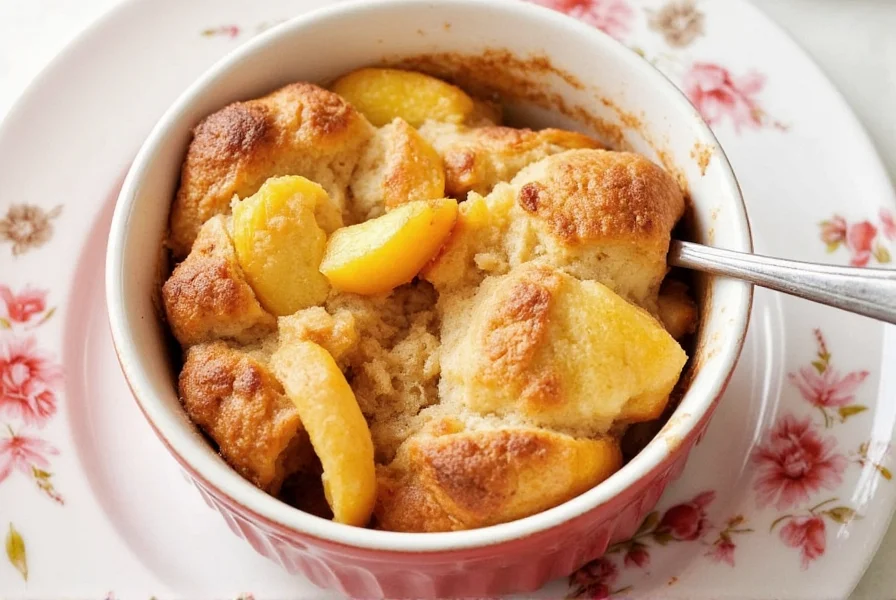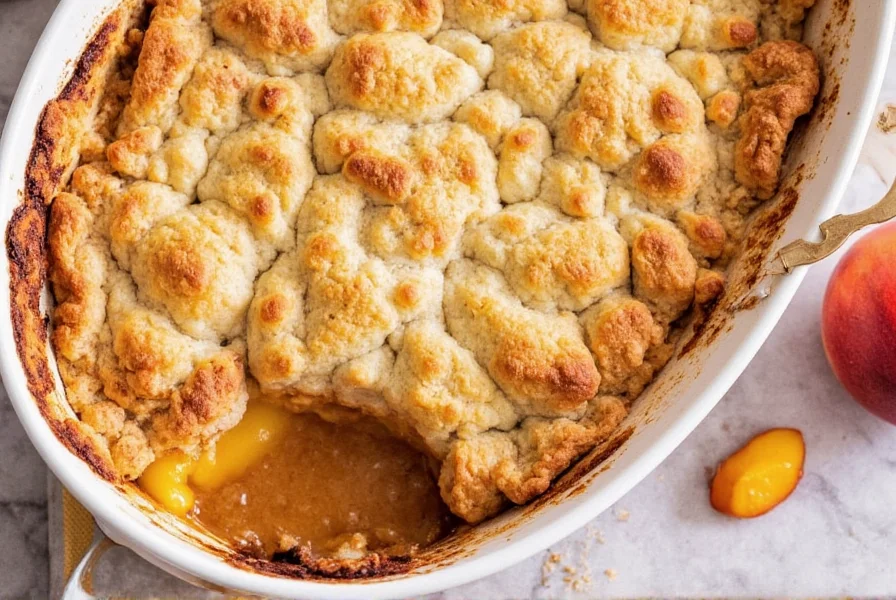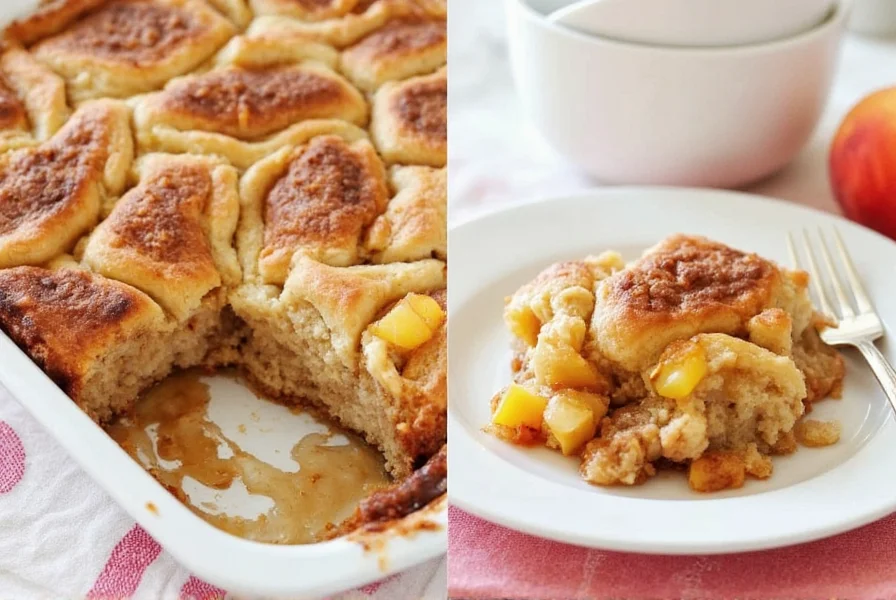Cinnamon roll peach cobbler is a creative hybrid dessert that combines the buttery, cinnamon-spiced layers of cinnamon rolls with the juicy, sweet-tart filling of traditional peach cobbler. This innovative dessert features a bottom layer of cooked peaches topped with cinnamon roll dough pieces that bake into a golden, gooey topping. The result is a single-baking-pan dessert with the comforting flavors of both classics—ideal for brunches, potlucks, or special occasions when you want to impress with minimal effort.
For home bakers seeking to elevate their dessert repertoire, the cinnamon roll peach cobbler represents the perfect fusion of two beloved American classics. This innovative dessert solves the common dilemma of choosing between a fruit-based cobbler and a yeast-raised pastry by combining both elements into one harmonious creation. Unlike traditional cobblers that use biscuit or cake toppings, this version incorporates cinnamon roll components—either homemade or store-bought—for a richer, more complex flavor profile with that signature swirl of cinnamon and sugar.
The Science Behind the Perfect Cinnamon Roll Peach Cobbler
Understanding the chemistry of this hybrid dessert is crucial for consistent results. The magic happens through three key interactions: the peach filling's liquid content, the dough's absorption capacity, and the caramelization process during baking. When peaches cook, they release natural pectin and juices that would typically make a cobbler soggy. However, the cinnamon roll dough acts as both topping and absorber, creating distinct layers while preventing sogginess.
Professional bakers recommend using slightly underripe peaches for optimal texture—they hold their shape better during baking while still providing sufficient juice. The cinnamon roll component should contain adequate fat content (butter or shortening) to create steam pockets that lift the dough while protecting the peach layer beneath.
Essential Ingredients Breakdown
Creating an exceptional cinnamon roll peach cobbler requires attention to ingredient quality and proportions. Here's what makes each component critical:
| Component | Key Ingredients | Why It Matters |
|---|---|---|
| Peach Filling | Fresh peaches, lemon juice, cornstarch, brown sugar | Lemon juice prevents browning while cornstarch thickens juices without cloudiness |
| Cinnamon Roll Base | Butter, cinnamon, sugar, yeast dough | Butter creates steam pockets; proper sugar ratio ensures caramelization without burning |
| Finishing Touches | Vanilla ice cream, whipped cream, caramel drizzle | Temperature contrast enhances flavor perception and texture experience |

Step-by-Step Preparation Guide
Follow these professional techniques for flawless results every time:
- Prepare the peach layer: Peel and slice 6 cups of firm peaches. Toss with 1/4 cup brown sugar, 2 tablespoons cornstarch, 1 tablespoon lemon juice, and 1 teaspoon vanilla. Arrange in a greased 9x13 baking dish.
- Prepare the cinnamon roll component: If using homemade dough, roll out to 1/4-inch thickness and cut into 1-inch strips. Brush with melted butter, then sprinkle generously with cinnamon-sugar mixture (1/2 cup sugar + 2 tablespoons cinnamon). Roll each strip into a spiral.
- Assembly technique: Place cinnamon rolls evenly over peach layer, leaving small gaps between rolls for steam to escape. This prevents soggy bottoms while allowing the rolls to expand properly.
- Baking protocol: Bake at 350°F (175°C) for 35-40 minutes until the topping is golden brown and the peach filling is bubbling at the edges. The internal temperature should reach 190°F (88°C) for perfect set.
- Cooling importance: Allow the cobbler to rest for at least 20 minutes before serving. This critical step allows the filling to thicken properly.
Avoiding Common Cinnamon Roll Peach Cobbler Mistakes
Even experienced bakers encounter pitfalls with this hybrid dessert. Here's how to avoid them:
- Soggy bottom syndrome: Caused by excessive peach liquid. Solution: Always use cornstarch (not flour) for thickening and let peaches macerate for 15 minutes before baking to draw out excess moisture.
- Dry topping: Results from overbaking or insufficient butter. Fix: Brush rolls with melted butter before baking and cover loosely with foil if browning too quickly.
- Collapsed structure: Occurs when yeast dough hasn't properly proofed. Prevention: Allow rolls to rise until nearly doubled (about 30 minutes) before baking.

Variations for Every Occasion
Customize your cinnamon roll peach cobbler for different dietary needs and preferences:
- Make-ahead version: Assemble the cobbler through step 3, then refrigerate overnight. Add 5-7 minutes to baking time if starting from cold.
- Gluten-free adaptation: Use gluten-free cinnamon rolls and increase cornstarch in filling by 50% to compensate for different absorption rates.
- Spiced variation: Add 1/4 teaspoon each of nutmeg and cardamom to the cinnamon-sugar mixture for deeper flavor complexity.
- Individual servings: Prepare in ramekins for elegant presentation at brunch gatherings.
Serving and Storage Recommendations
Maximize enjoyment of your cinnamon roll peach cobbler with these professional tips:
- Optimal serving temperature: Serve warm (not hot) at 140-150°F (60-65°C) to fully appreciate both the peach filling and dough textures.
- Storage protocol: Keep covered at room temperature for up to 24 hours. Refrigerate for longer storage (up to 3 days), but always reheat before serving.
- Reheating method: Warm individual portions in the microwave for 30-45 seconds, or entire cobbler at 300°F (150°C) for 15-20 minutes.
- Freezing potential: This dessert freezes well for up to 2 months. Thaw overnight in refrigerator before reheating.
Why This Hybrid Dessert Works So Well
The success of cinnamon roll peach cobbler lies in complementary flavor chemistry. Peaches contain gamma-decalactone, a compound that enhances sweet, creamy notes—perfectly matching the dairy elements in cinnamon roll dough. Meanwhile, the cinnamaldehyde in cinnamon interacts with peach esters to create new flavor compounds that neither dessert produces alone. This molecular synergy explains why the combination feels familiar yet excitingly novel.











 浙公网安备
33010002000092号
浙公网安备
33010002000092号 浙B2-20120091-4
浙B2-20120091-4